Middle Foot Pain And Swelling (Walking, Running): 7 Causes
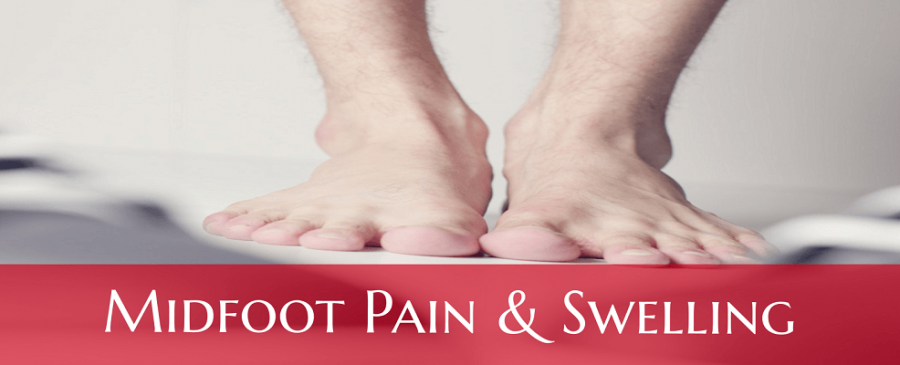
Last updated on July 26th, 2018 at 04:25 pm
Question: What causes middle foot pain? Are there effective home remedies for pain in the middle of foot?
According to the 2014 survey from the American Podiatric Medical Association, more than 75 percent of Americans will have pain in the foot. So, if you’re experiencing mild or severe pain in your foot, you are not alone.
In some cases, pain in the middle of foot happens because of poorly planned exercise. For example, having a high-intensity workout with virtually no warm-up may cause pain in your foot. If this is the case, it is likely nothing serious.
Having said that, a long-standing pain in the middle of your foot especially when walking or running may be due to serious medical issues. In fact, in some cases, surgery may be required.
Common causes of pain in the middle of foot are
- Cuboid syndrome
- Navicular bone fracture
- Midfoot cellulitis
- Bruised inflamed foot
- Fracture of the tarsal bones
- Midtarsal joint sprain
- Extensor tendonitis
- Plantar fascitis
- Tendinopathies
So, if your upper or lower midfoot hurts, talking to your doctor becomes essential.  Here are questions your doctor will ask you
Here are questions your doctor will ask you
- When did pain in the middle of the foot start?
- Do you feel pain in the upper or lower part of the midfoot?
- Is pain on the inside or outside of the foot?
- Does pain get worse while walking, running or jumping?
- Does pain get worse while getting out of your bed in the morning?
- Do you also experience swelling of the middle of the foot?
- What makes your pain worse or relieves it?
- Any prior trauma to your legs, ankle or foot bones?
This article explains the causes of midfoot pain and treatment options.
Understanding Midfoot Anatomy
The human foot is made up of 26 bones which are divided into the hindfoot, midfoot and the forefoot.
At the back of the foot is the hindfoot which is formed by the lower end of the shin bones (tibia and fibula) and the ankle bones (talus and calcaneus).
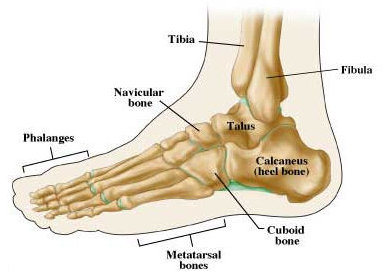 In front of the hindfoot are the midfoot bones. They are the Navicular bone, cuboid bone, and three cuneiform bones that lie side by side.
In front of the hindfoot are the midfoot bones. They are the Navicular bone, cuboid bone, and three cuneiform bones that lie side by side.
The Navicular bone lies at the inner side of the foot (medial end) just behind the cuneiform bone and in front of the talus bone. The cuboid bone is on the outside of the foot behind the metatarsal bone and in front of the calcaneus.
What causes Middle foot pain and swelling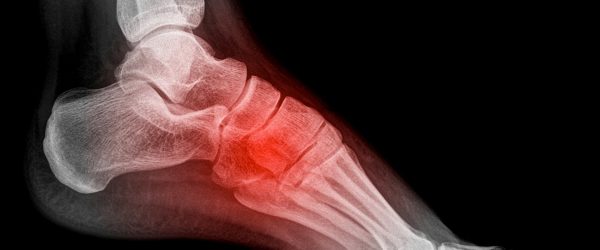
First of all, mild pain in the middle of your foot can happen due to a minor skin or ligament injury. If this is the case, pain and swelling usually subside within 24 hours.
However, swelling and pain in the midfoot that is lasting for days or weeks with the inability to bear weight will need urgent medical treatment.
Here are common causes of middle foot pain and swelling
1. Cuboid syndrome
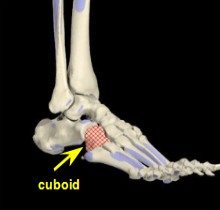 The cuboid bone is located at the outer part of the foot, and it is held in place by joints and ligaments. If the ligaments get torn or inflamed, it affects the stability if the cuboid bone, resulting in displacement.
The cuboid bone is located at the outer part of the foot, and it is held in place by joints and ligaments. If the ligaments get torn or inflamed, it affects the stability if the cuboid bone, resulting in displacement.
During cuboid syndrome, the cuboid bone is out of its anatomical position, but not entirely out of place. This results in pain on the lateral side of the midfoot.
What are the symptoms of cuboid syndrome?
- Pain in the middle of the foot
- Pain in the outside of the midfoot
- Severe pain at the metatarsal bones near the little toes
- Inflammation and redness of the middle part of the foot over the cuboid bone
- Swelling of the middle of the foot
Who are at risk of Cuboid syndrome?
Typically, foot injuries are common in athletes because of repetitive overuse of the foot. There is also the risk of cuboid syndrome in people who have been diagnosed with osteoarthritis or osteoporosis. Other risk factors are
- Running or walking on an uneven surface with a displacement of the calcaneocuboid joint and its ligaments.
- Wearing running shoes that are tight or using tight shoes with a hard upper surface.
- Obesity
- Repetitive side to side movement
How is cuboid syndrome treated?
Pain in the middle of the foot on the outer side is likely because of cuboid injury. Here are simple ways to alleviate symptoms.
- Rest foot to allow healing to occur
- Use ice on your foot
- Apply compression bandage
- Elevate your foot while resting
- Foot manipulation will be done by your doctor to fix bone back to shape.
2. Navicular bone fracture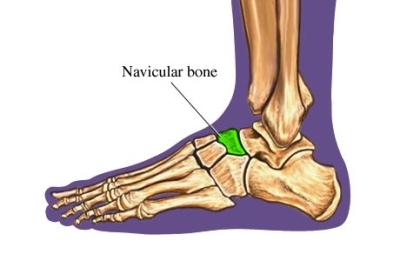
Another cause of pain in the middle of the foot is a navicular stress fracture. The navicular bone is found on the inner side of the foot just in front of the talus bone.
If the navicular bone gets fractured, pain on the inner side of the midfoot is not uncommon. Stress fracture of the navicular bone happens from repetitive use of the foot bone especially while running or jumping.
What symptoms to expect?
- Dorsal foot pain on the medial side of the foot
- Pain when walking and running
- Rarely, swelling of the middle of the foot
How is navicular fracture treated?
If you experience midfoot pain on the inner side of the foot, it is important you see your doctor to rule out a navicular fracture.
Oftentimes, Navicular fractures are tricky to diagnose, and your doctor may request several investigations to detect the fracture. These include Xray, MRI, CT, and Bone scan. Just after a navicular fracture, an x-ray is insufficient to make a diagnosis as your foot will appear normal.
If a navicular fracture is identified, your doctor will request immobilization of the affected foot. This is needed for healing to occur. In rare cases, surgery will be required especially when bone is severely fractured and displaced.
3. Bruised foot/ Cellulitis
Direct injury to the skin of your foot can cause swelling and pain. If a break in the skin covering the midfoot occurs, there is a risk of bacterial contamination. If this happens, there is a risk of skin infection called cellulitis.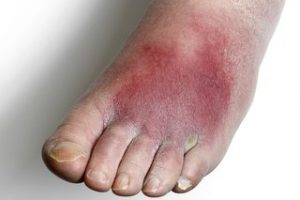
Symptoms of cellulitis are
- Red, inflamed foot
- Swelling of the foot
- Increased warmth of the affected foot (compare to the other foot)
- Fever
- Blister on foot
- In severe cases, pus collections (abscess)
How is cellulitis treated?
If you have the above-listed symptoms with a middle of foot pain, talk to your doctor as early as possible. Treatment is necessary to prevent full-blown sepsis, pus collection (abscess), and formation of a foot ulcer.
Treatment involves taking antibiotics for about two weeks. Also, painkillers will be prescribed for pain relief.
4. Extensor Tendonitis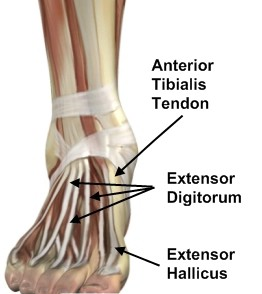
Pain in the middle of the foot when walking or running may also occur from Extensor tendonitis.
Extensor tendonitis means inflammation of the long tendons that run over the middle of your foot. These tendons extend from your legs, pass through the foot and get attached to the digits.
Symptoms of extensor tendonitis are
- Top of foot pain that worsens during walking or running and subside at rest
- Swelling at the top of the foot
Treatment involves the use of RICE THERAPY (R for REST, I for ICE, C for COMPRESSION, and E for LEG ELEVATION).
5. Plantar fasciitis
Plantar fasciitis can cause pain in the bottom middle part of the foot. In simple terms, plantar fasciitis means inflammation of the plantar fascia that extends from your heel to the metatarsal bones.
When inflamed or injured, severe pain at your foot just after getting up from the bed is common. Pain may also occur after exercise or after rising from a sitting position.
6. Midfoot Arthritis
Arthritis of the midfoot bone can cause mild or severe pain. Pain worsens when walking, running or standing.
Pain in the middle of foot (FAQ)
What causes pain in the middle of foot when pressure applied?
If you experience pain when pressure is applied to your foot, its likely because of
- Cuboid syndrome (If the pain is on the outer side)
- Navicular fracture (If the pain is on the inner side)
- Midfoot Arthritis
- Extensor tendonitis
- Midtarsal joint sprain
- Direct foot injury
- Cellulitis (Obvious skin redness, pain, and warmth)
